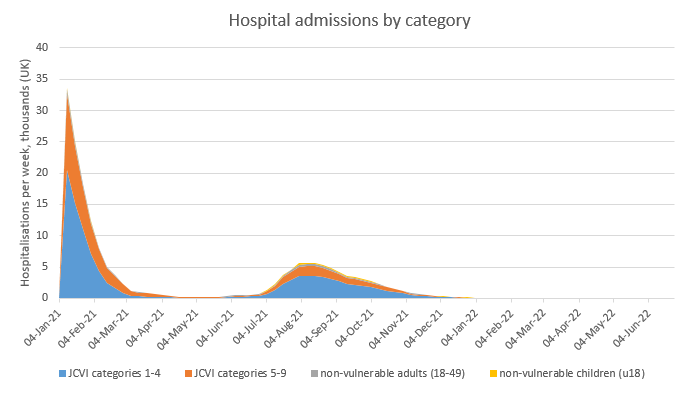
As an addendum to this earlier post, some have asked whether similar analysis is available for hospitalisations and deaths, and if so, does it show the same pattern? Happily, I looked at this at the weekend, and the answer is: yes and no. 1/10
https://twitter.com/JamesWard73/status/1371522265658056707?s=20
To start with, a quick note on methods. To compare cases, deaths and hospitalisations on the same chart we are constrained to use age groups for which hospital data is readily available i.e. 18-64, 65-84 and 85+. So I’ve used the (mostly unvaccinated) 18-64 group... 2/10
… as a benchmark for the other two groups, creating deviation charts similar to my earlier ones for cases. See below for the new charts for cases, admissions and deaths. But it will be more useful to compare the different data for the same age group on the same chart 3/10 





…and it’s even more useful if we align the data – so I’ve brought the admissions data forward by 8 days, and the deaths by 20 days to (roughly) align them with cases. (feel free to tell me I’ve got the lags wrong – all suggestions welcome, particularly with data). 4/10
Here’s the 85+ on that basis: it looks like admissions are tracking cases fairly closely, until the last week or so when they’ve pulled up a bit. Deaths, on the other hand, seem to be coming down faster and earlier than cases or hospital admissions. 5/10 

And here’s the 65-84, with a similar-ish pattern. Again, hospitalisations are tracking cases pretty closely, although without the recent pull-up in this group. And deaths are showing more benefit, ahead of cases and admissions. 6/10 

One obvious question is: why are we not seeing more overall benefit? Surely the 85+ were nearly all vaccinated by 7th Feb, so by end of Feb we should be seeing 80%+ protection vs. hospitalisation and death? Well, we don’t have data for deaths coming out that far yet, 7/10
…and I also believe that the case data is being distorted by the weaker effect of lockdown on older age groups – which may be pushing up the over-80s cases (as a % of the total) as it did in Lockdown 2 in November, thereby diluting the vaccine effect. 8/n 

Still, that doesn’t really explain why we aren’t seeing bigger benefits in hospital admissions. Others have suggested reasons for this e.g. it could be that when hospitals were full in January, there was greater rationing of healthcare for the over-85s than for other groups, 9/n
…which has then unwound during Feb/March, creating an apparent (relative) rise in hospital admissions in that group. Alternatively, proportionately more infections could be being acquired in hospital, which might create a similar effect. Other ideas very welcome. /end
@ThatRyanChap this may be interesting - I've changed the presentation a bit since you last saw this, adjusting for the usual time lags, which gives a closer fit between cases and admissions - but there's still that uplift in the 85+ to explain
• • •
Missing some Tweet in this thread? You can try to
force a refresh









